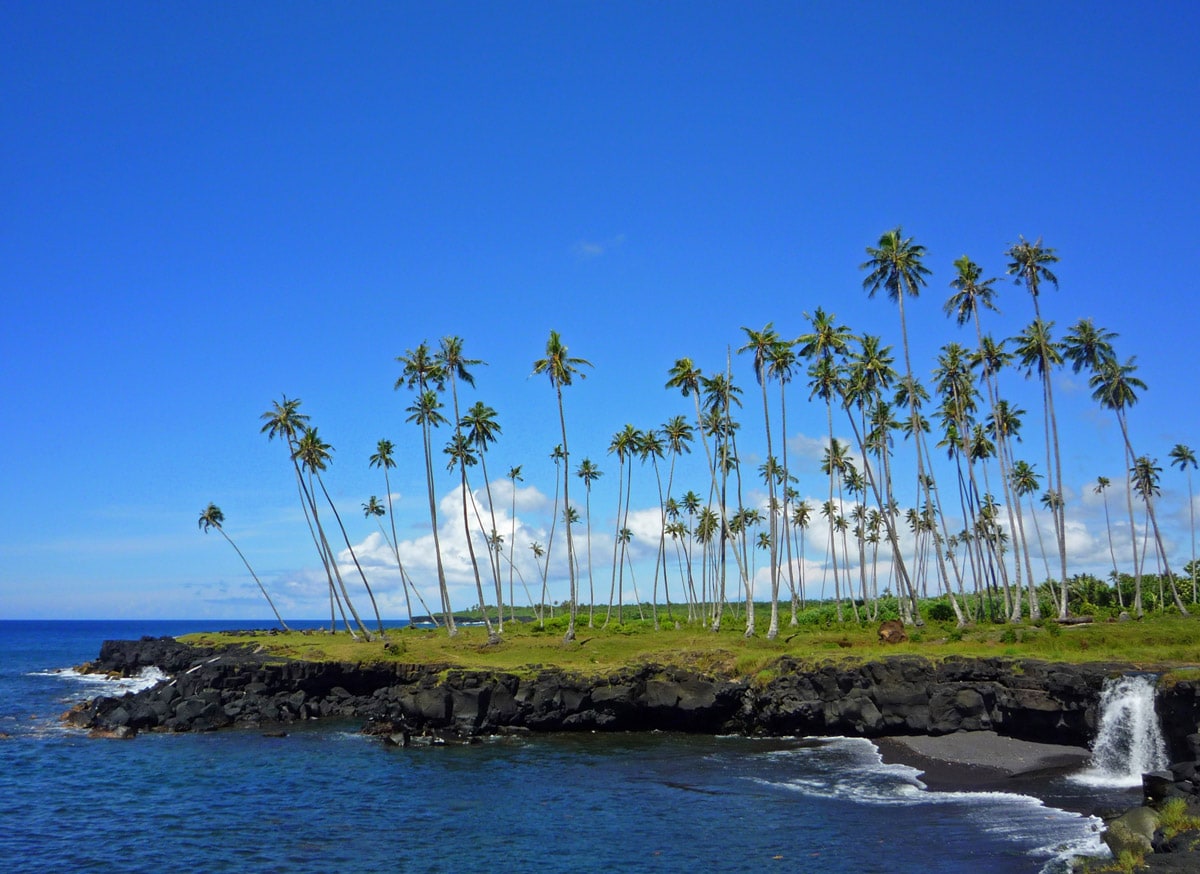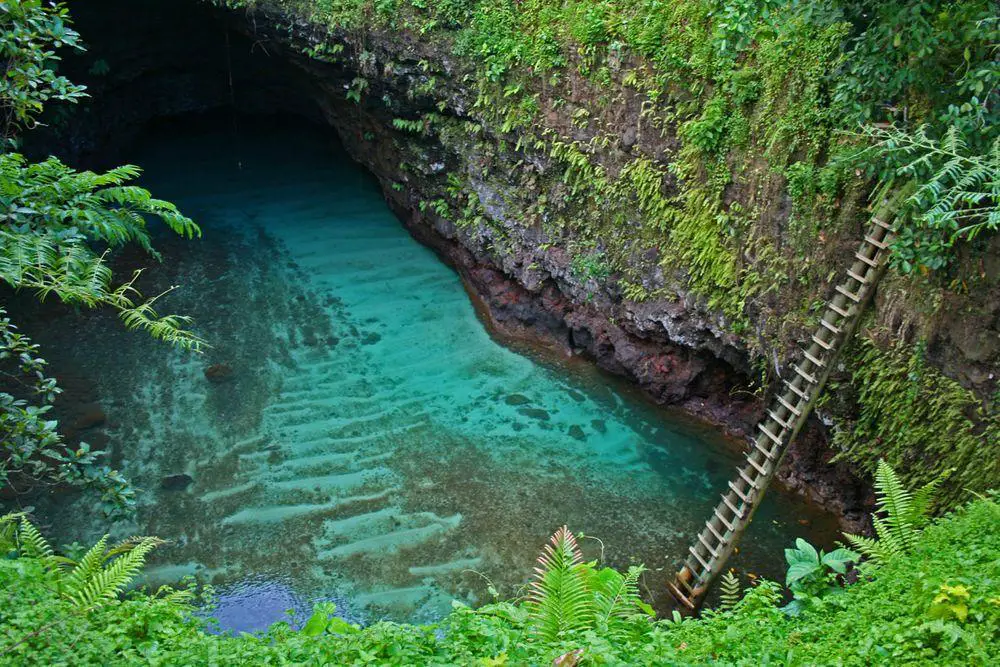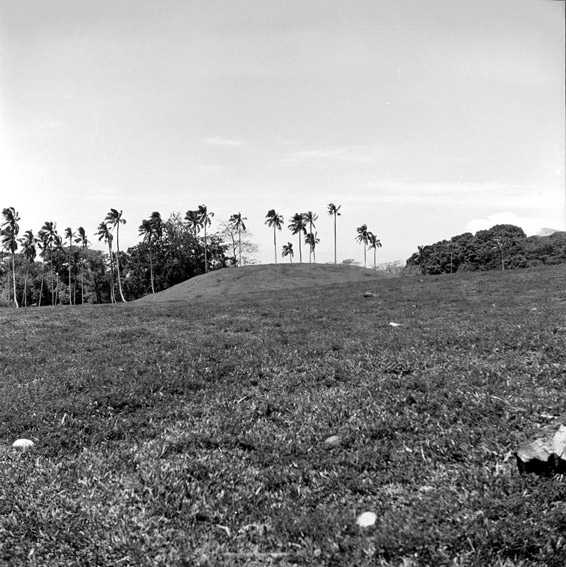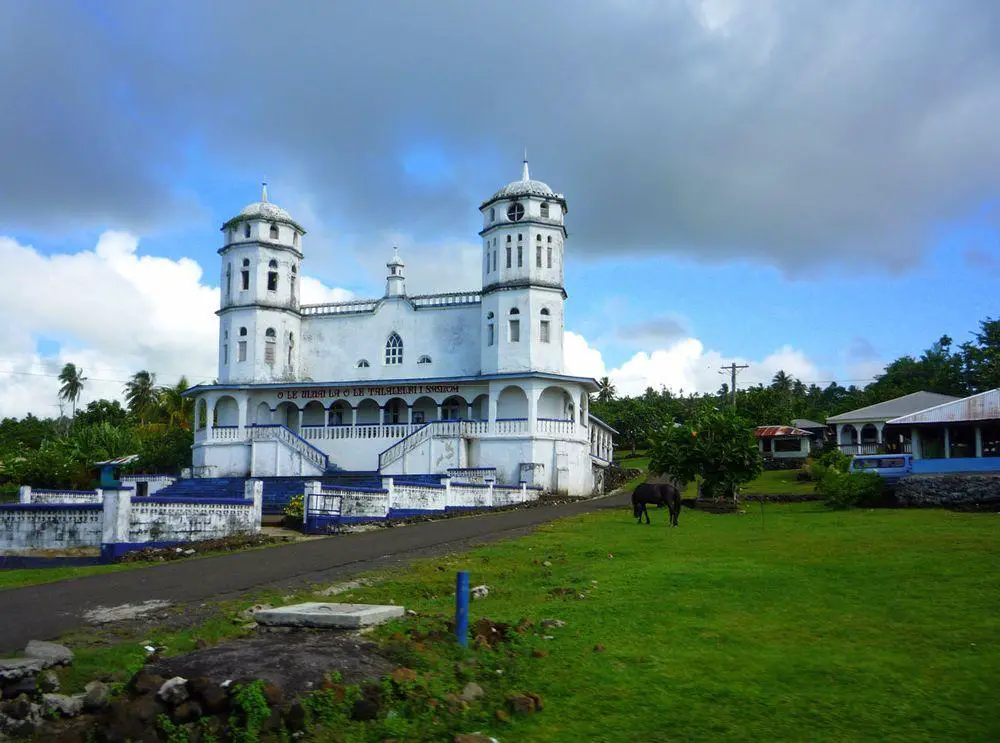Wondermondo 🢖 World 🢖 Wonders of Australia and Oceania 🢖 Wonders of Polynesia 🢖 Wonders of Samoa
Territory
Wonders of Samoa

 Highlights
Highlights
This country basically consists of two large (by Polynesian standard) islands – Savai’i and Upolu. Samoa is true Polynesia – and many believe – the cradle of Polynesia.
The natural and cultural heritage of Samoa is rather rich and some landmarks are truly surprising. The most amazing wonders of Samoa are:
- Lava caves and associated phenomena – the numerous volcanoes of Samoa have created wast lava fields. Here have formed numerous interesting caves – lava tubes with sinkholes, waterfalls, powerful springs, archaeological heritage. In some places, the interaction of waves and lava tubes has created some of the most spectacular blowholes in the world.
- Archaeological heritage – interesting are the ancient star mounds and the caves which served as a kind of ancient towns with hundreds of stone platforms for cave dwellers. The country is rich with the sites of legends.
- Waterfalls – here are located many spectacular waterfalls – not just steep rapids but true, vertical plunges in romantic, spectacular jungle setting.
Map with the described wonders
If you see this after your page is loaded completely, leafletJS files are missing.
 Top 24 wonders of Samoa
Top 24 wonders of Samoa
Geological wonders
Saleaula Lava Field
A lava stream from Mount Matavanu that buried 5 villages. Especially impressive are the ruins of church, filled with lava. "Virgins Grave" is a burial place of nuns that miraculously was not covered by lava.
To Sua and Tolesua
Two adjacent sinkholes – windows in a large lava tube. To Sua sinkhole is 30 m deep. Sinkholes are filled with marine water. Contains an endemic shrimp Hamalpheus acanthops.

Alofaaga Blowholes (Taga Blowholes)
Some of the most powerful blowholes in the world, water fountains rise up to 30 m high. These blowholes exist thanks to a system of lava tubes that reach the ocean here. Local tourist guides put the coconuts in the holes and they are blasted high in the air.
Salamumu Cave 1 (Ana Pe’ape’a)
3 487 m long lava tube cave – the longest known cave in Samoa. Contains artifacts by people who lived here in prehistoric times – stone platforms. In the cave were living hundreds or thousands of people during the war times. Cave contains an unusual form of lava that has a consistency of soft cheese. When walking on such lava, people sink into it.
Sinaloa Waterfall
The tallest waterfall in Samoa – 180 – 250 m tall waterfall, sliding down along a nearly vertical cliff. Located in a beautiful jungle setting in the most pristine area in Samoa.
Fuipisia Falls
Free falling, 55 m high waterfall in lush jungle.
Papapapai-Tai
Magnificent, free-falling 100 m tall waterfall that plunges into a deep pool.
Piula Cave Pool
Natural spring pool in a lava cave with a steam flowing out from it.
Tafatafa Cave (Ana Pe’ape’a at Tafa-Tafa)
1.8 km long lava tube.
Mu Pagoa Waterfall
Low but wide waterfall. Here the largest river in Samoa falls directly into the ocean. Unusual, beautiful landscape.
Ana Pe’ape’a at Tapuele’ele
One of the deepest caves in Samoa – 74 m deep. The entrance in this lava cave is an impressive sinkhole, 25 m deep, with a diameter of 100 m.
Mata o le Alelo
Legendary natural spring, flowing out of lava cave.
Biological wonders
Central Savai’i Rainforest
The largest (72,699 ha) remaining rainforest in Polynesia. In this exotic forest are located more than 100 volcanic craters, some with recent lava fields. Amazing cloud forest constantly covered with fog. Numerous endemic species of plants and animals, new ones are still being discovered. Magnificent scenery with tall waterfalls, and cliffs.
Archaeological wonders
Pulemelei Mound (Tia Seu Mound)
The largest man-made mound in the Pacific. This pyramid-shaped mound is made of stone, up to 12 m high, with 65 x 60 m long sides. Built around 1100 – 1400 AD.
Vailele Mounds
Group of eight mounds that are formed like rectangular, cut pyramids. The largest mound is the 12 m high Laupule mound. Built around 1600 AD.

Seuao Cave
570 m long lava tube cave. There are located well-preserved remnants of human settlement including some 250 m long sequence of stone platforms.
Mulifanua star mound
A mound with ten extensions that resembles a ten-pointed star – an example of the numerous star mounds of Samoa. Such star mounds were built mostly in 1700 – 1900 AD. Excavations did not find any post holes or burials. The purpose of this impressive construction is unknown.
Fale O Le Fe’e
Ruins of a megalithic structure. Some 60 large natural columns of basalt lie on the ground, forming a distinct elliptical structure with a smaller structure at one side. The largest basalt column is 1.75 m long. The age and purpose of the structure are unknown.
Falemauga Caves (Falemaunga)
Two giant caverns in a collapsed lava tunnel, a site of prehistoric settlement. Here was built a system of rock platforms – in total 159 platforms made of stones. Found also herds. The Large Falemauga Cave is 545 m long.
Mulifanua Ferry Berth site
The oldest known human settlement in Polynesia. The site is located 2.25 m below sea level and here were found Lapita pottery shards that were made around 1 000 BC.
Architecture and legendary wonders
Sapapali’i Church
Sapapali’i is the first village where a Christian missionary – John Williams – arrived in 1830. Now there is a very impressive church.
Safotu Church
A magnificent church with two towers, built in the Neo-Baroque style.
Paia Dwarfs Cave
A small lava cave. According to the local legends here live dwarves and their footprints can be found often.
Ana Va’atausili (Vaatausili Cave) and Blood Well
A lava cave with a 2 m deep pool. The cave is taboo – its water often is red. According to the legends of local people, this is the blood of warriors. Water is colored by numerous small Cladocera crustaceans.
 Recommended books
Recommended books
Quest for the Real Samoa: The Mead/Freeman Controversy and Beyond
Mr. Holmes’ study is . . . the basic stuff of competent ethnography, that combination of science and art in which the details of daily life are systematically observed, analyzed and constructed into a cultural account. . . He concludes that Margaret Mead was essentially correct in her depiction of coming of age in Samoa in 1925, concerned as she was to compare it with adolescence in the United States at that time. New York Times Book Review.
Pisikoa: South Pacific Diary ’78-’80-Enduring Uncle Mikey
True journal of many zany experiences during an interesting 2 years in the Samoan Islands as a teacher and temporary member of a Polynesian family. Personal development & reflections of what such a beautiful culture and its interesting people can teach a teacher, despite all intentions in reverse order, located in a truly idyllic setting.





thank you very much , I used this info for my researching for school.
I am really glad that I could help out!